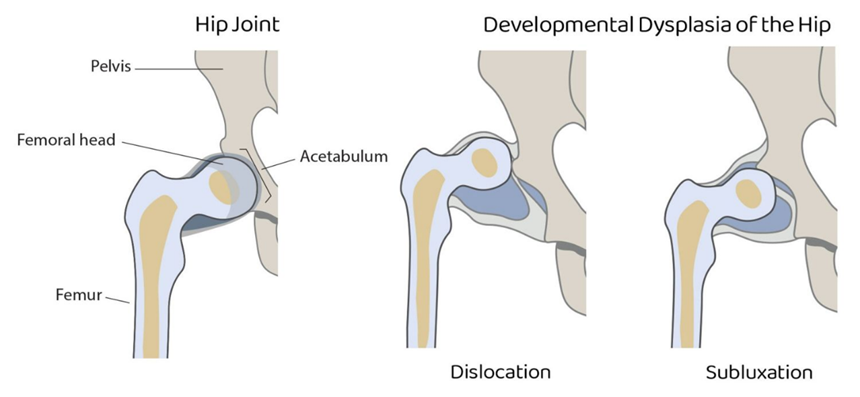The nurse is caring for an infant with developmental dysplasia of the hip. Which clinical manifestations would the nurse expect to observe? (Select all that apply.)
Positive Ortolani click
Unequal gluteal folds
Trendelenburg sign
Negative Babinski sign
Telescoping of the affected limb
Correct Answer : A,B,C,E
The correct answer is a) Positive Ortolani click, b) Unequal gluteal folds, c) Trendelenburg sign, and e) Telescoping of the affected limb.
Choice A reason:
A positive Ortolani click is a clinical manifestation of developmental dysplasia of the hip (DDH). The Ortolani maneuver is used to detect hip dislocation or subluxation in infants. When the hip is abducted and gentle pressure is applied to the proximal thigh from behind, a palpable “clunk” is noticed as the femoral head relocates into the acetabulum. This indicates hip instability, which is a characteristic of DDH.

Choice B reason:
Unequal gluteal folds are another clinical manifestation of DDH. Asymmetrical gluteal creases can suggest hip dysplasia in infants. This is because the dislocation or subluxation of the hip can cause one leg to appear shorter than the other, leading to uneven gluteal folds.
Choice C reason:
The Trendelenburg sign is a clinical test used to assess the integrity and strength of the hip abductor muscles, particularly the gluteus medius and gluteus minimus. A positive Trendelenburg sign usually indicates weakness in these muscles, which can be associated with hip abnormalities such as congenital hip dislocation3. In DDH, the hip instability can lead to a positive Trendelenburg sign.
Choice D reason:
A negative Babinski sign is not a clinical manifestation of DDH. The Babinski reflex is a normal reflex in infants up to 2 years old, where the big toe moves upward and the other toes fan out when the sole of the foot is stroked. A negative Babinski sign would indicate the absence of this reflex, which is not related to DDH.
Choice E reason:
Telescoping of the affected limb is a clinical manifestation of DDH. In a child with DDH, the hip socket is shallow, and the head of the femur may slip in and out, leading to a telescoping effect. This means the femoral head can move further out of the socket, causing the limb to appear shorter or longer depending on the position.
Nursing Test Bank
Naxlex Comprehensive Predictor Exams
Related Questions
Correct Answer is D
Explanation
Choice A reason:
Bilious vomiting and constipation are not typical manifestations of hypertrophic pyloric stenosis. Bilious vomiting, which is green or yellow, indicates that the vomit contains bile and is usually associated with intestinal obstruction beyond the stomach. Hypertrophic pyloric stenosis typically causes non-bilious, projectile vomiting because the obstruction is at the pylorus, before the bile duct.
Choice B reason:
Abdominal distention and currant jelly-like stools are not indicative of hypertrophic pyloric stenosis. Currant jelly-like stools are a classic sign of intussusception, a different condition where part of the intestine telescopes into itself. While abdominal distention can occur in pyloric stenosis, the presence of currant jelly-like stools points to a different diagnosis.
Choice C reason:
A rounded abdomen and hypoactive bowel sounds can be seen in various gastrointestinal conditions but are not specific to hypertrophic pyloric stenosis. While a rounded abdomen may be present due to gastric distention, hypoactive bowel sounds are not a hallmark of this condition. The primary symptom of pyloric stenosis is projectile vomiting.
Choice D reason:
Ravenously hungry after vomiting is a classic manifestation of hypertrophic pyloric stenosis. Infants with this condition often vomit forcefully after feeding and then appear hungry again because the food does not pass through the pylorus into the intestines. This symptom, along with projectile vomiting, is a key indicator of pyloric stenosis.
Correct Answer is C
Explanation
The correct answer is c. An excessive destruction of platelets.
Choice A: Diffuse fibrin deposition in the microvasculature
Diffuse fibrin deposition in the microvasculature is not characteristic of immune thrombocytopenia (ITP). This description is more aligned with disseminated intravascular coagulation (DIC), a condition where widespread clotting occurs within the blood vessels, leading to multiple organ damage.
Choice B: Deficiency in the production rate of globin chains
A deficiency in the production rate of globin chains is associated with thalassemia, a genetic blood disorder that affects the production of hemoglobin. This is not related to the pathology of immune thrombocytopenia.
Choice C: An excessive destruction of platelets
An excessive destruction of platelets is the hallmark of immune thrombocytopenia (ITP). In ITP, the immune system mistakenly targets and destroys platelets, which are essential for blood clotting. This leads to a low platelet count and an increased risk of bleeding.
Choice D: Bone marrow failure in which all elements are suppressed
Bone marrow failure in which all elements are suppressed is characteristic of aplastic anemia, a condition where the bone marrow fails to produce sufficient blood cells. This is not related to immune thrombocytopenia.
Whether you are a student looking to ace your exams or a practicing nurse seeking to enhance your expertise , our nursing education contents will empower you with the confidence and competence to make a difference in the lives of patients and become a respected leader in the healthcare field.
Visit Naxlex, invest in your future and unlock endless possibilities with our unparalleled nursing education contents today
Report Wrong Answer on the Current Question
Do you disagree with the answer? If yes, what is your expected answer? Explain.
Kindly be descriptive with the issue you are facing.
